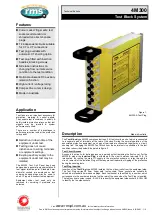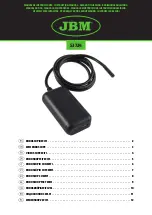
Visit
www.rmspl.com.au
for the latest product information.
Due to RMS continuous product improvement policy this information is subject to change without notice. 4M300/Issue K 10/08/21 - 1/6
Features
◼
Colour coded
‘finger safe’ test
sockets suit standard or
shrouded type 4mm banana
plugs
◼
14 independent circuits suitable
for CT or VT connections
◼
Test plug available with
automatic CT shorting option
◼
Test plug fitted with insertion
handles & locking screws
◼
Side label instructions on
changing from normal service
condition to the test condition
◼
Optional automatic DC auxiliary
isolation function
◼
High current / voltage rating
◼
Compact & economic design
◼
Made in Australia
Application
Test links are an important accessory for
protection, metering & control panels.
They enable test technicians to quickly &
safely isolate protection relays so that test
signals may be injected & system
performance verified.
There are a number of advantages in
performing injection tests at the protection
relay panel:
◼
Reduction in down time of the
equipment under test.
◼
Testing does not cause
disturbance to wiring, terminals
or equipment settings.
◼
Existing auxiliary supply to the
equipment under test may be
isolated.
The 4M300 Test Link Panel has been
designed as a general-purpose isolation &
test signal injection point. Standard 4mm
diameter sockets are employed so that
common banana plugs may be used to
short CT inputs & connect test equipment.
Equipment under test need only be
removed for servicing if problems are
detected.
Technical Bulletin
4M300
Test Block System
Figure 1:
4M320-A Test Plug
Description
Made in Australia
The
Test Block
type 4M300 comprises fourteen (14) test circuits, each of which is connected
to a separate pair of terminals at the rear of the case. During the normal operation of the
associated protection equipment, each pair of terminals are connected together by a circuit-
shorting link. Changing the 4M300 Test Block from the normal service condition to the test
condition is described below & depicted in figure 3:
Test Circuit Access
Access to the circuits, for testing purposes, is gained by first removing the front cover. For the
4M300-B model the
Isolation Plug
is withdrawn & the circuit between terminals 13 & 14
interrupted. By routing the main DC supply to the protection scheme or relay through this
circuit, removal of the Isolation Plug will thereby prevent inadvertent tripping of the protection
during the ensuing tests.
Test Plug Insertion
Insertion of the
Test Plug
type 4M320, isolates the live side circuits from the equipment side.
The Test Plug carries 28 4mm
‘finger safe’ test sockets. These sockets are suitable for
shrouded or standard 4mm banana plugs. Each test socket is identified by a number, which
corresponds to the numbered terminal on the rear of the case when the Test Plug is inserted.
The test socks are colour coded - BLACK to indentify the equipment side sockets & YELLOW
to identify the live side sockets.
























